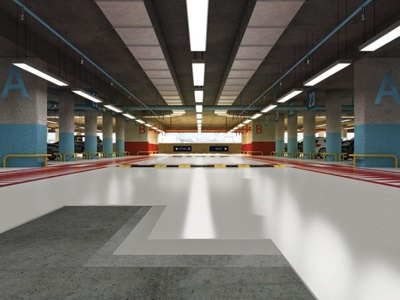
Parking lots, indoor parking garages, pedestrian walkways and even balconies are important parts of infrastructure that require protection and maintenance to make sure that they maintain structural integrity throughout their service life.
These structures are generally built using poured, or precast concrete, which can develop hairline cracks over time as they are exposed to high volumes of traffic and harsh elements in certain climates.
As an important part of general and preventive maintenance for parking structures of all kinds, parking deck coating systems help ensure that the traffic deck of your structure will withstand high-volume pedestrian and vehicular traffic and extend its service life.
Coating your structure with protective finishing layers also helps increase safety for the drivers, pedestrians and cyclists who use it every day! In this blog post we'll discuss what you need to know about parking deck products, how they are applied, as well as why installing them is so beneficial.

A parking deck coating system is applied to parking decks and other concrete surfaces to provide a protective layer. One key function of parking deck coatings is that they add protection against wear and abrasion caused by the parking lot's traffic, which can damage the parking deck surface and shorten its lifespan.
Parking lot parking decks require special attention in many places around the world because they must be resistant to the extreme weather conditions of the local climate, including very hot and cold temperatures as well as high amounts of rain or snow.
The integrity of parking deck surfaces can be undermined by the corrosion caused by water and salt intrusion, the effect of chemical agents and by-products of vehicular traffic, temperature variations, as well as wear and abrasion from regular use. But all of these issues can be mitigated through the application of a flexible, impermeable protective layer.

Top quality parking deck coating systems, such as the Mapefloor™ parking deck systems, are made up of three basic layers - a primer, basecoat and topcoat, which are all required for the coating system to function properly in its given environment.
Before applying either the basecoat or the topcoat, a high-quality primer, such as Primer SN™, a two-component epoxy primer, or Mapefloor PU Primer, a two-component polyurethane primer that can be used for initial applications or as a recoat primer, must be applied to ensure the proper adherence. The parking deck coating system's basecoat layer, Mapefloor PU 400 FC, provides the necessary flexibility to allow for above-grade movements in the substrate while also bridging hairline cracks to prevent water and other materials from infiltrating the surface. Basecoat layers provide increased adhesion between the primer and the topcoat layers.
Polyurethane topcoat layers, either Mapefloor Finish 450, which provides an aliphatic, UV resistant finishing element to protect areas exposed to direct sunlight, or Mapefloor Finish 415 NA, which helps protect against wear from traffic in indoor applications, are the last line of defense against the weather, traffic and other elements.
This combination of durability with flexibility is what makes a parking lot parking deck coating system so important in providing protection against wear, abrasion and stress. When parking decks are not properly protected, they can suffer from premature deterioration of the concrete's surface which will cause cracks, chips or other damage that can pose a threat to users and shorten the lifespan of the surface.

Offering versatile solutions for maintaining parking structures and concrete surfaces of all kinds, installing a Mapefloor parking deck system will help extend the service life of the surface, while offering improved aesthetics and increased safety for all users.
If you are considering the construction of a new parking deck, or you are looking for ways to give an existing surface a new lease on life, Mapefloor parking deck systems offer versatile solutions for long-term durability.

Comments
Load more comments